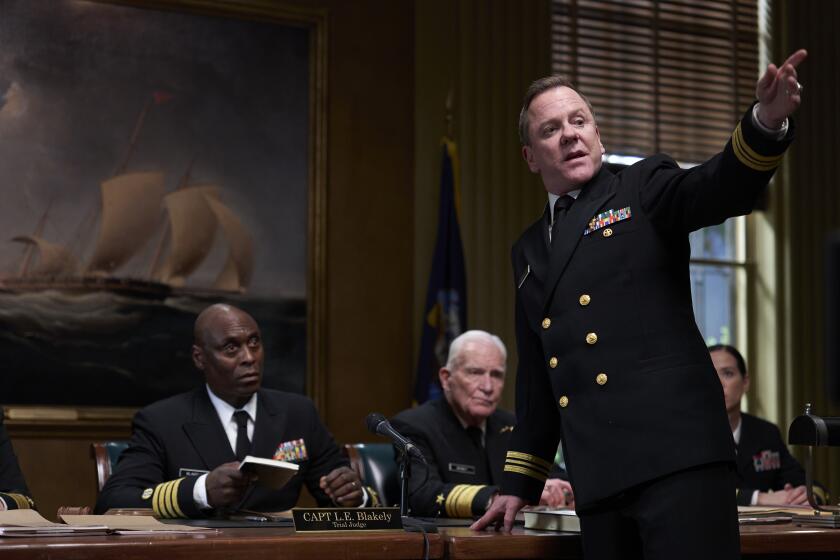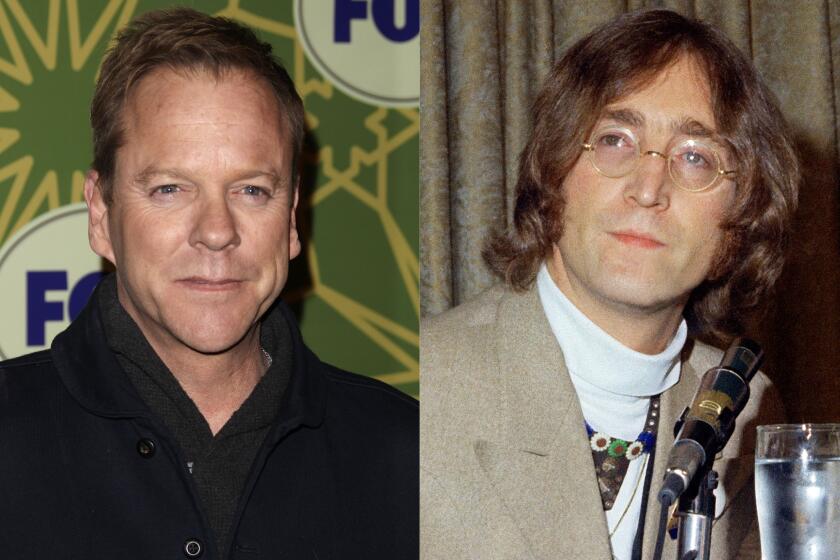
- Share via
In the taut, no-nonsense courtroom drama “The Caine Mutiny Court-Martial,” Kiefer Sutherland earns top billing in the pivotal role of Capt. Philip Queeg, the disgraced and (perhaps unjustly) deposed commander of a U.S. Navy minesweeper. But he appears onscreen for only two scenes.
And because he was working with the legendary director of “The French Connection” and “The Exorcist,” William Friedkin, on what would turn out to be his final feature, those two scenes of Queeg’s testimony were essentially shot in single takes.
“It was exciting doing it,” Sutherland says, “and then very frustrating finishing it, because Mr. Friedkin only wanted the one take. And I was like, ‘I’ve worked really hard on this. Can I at least have two?’”
The latest adaptation of Herman Wouk’s 1953 stage play is a tightly concentrated courtroom drama, well acted by Kiefer Sutherland, Lance Reddick and Jason Clarke.
So Sutherland started doing a second take, but noticed that Friedkin “was already editing the first take into what he had already cut together for the picture. So I realized halfway through the second take … I’m just wasting everybody’s time.”
Speaking on a chilly spring morning at a West Hollywood hotel, the 57-year-old actor conveys such respect for the late New Hollywood giant that he refers to him only as “Mr. Friedkin,” making clear that the honorific is his own tribute, not the director’s request.
For his iconic starring role on “24,” Sutherland got to spend a full decade developing the character of Jack Bauer. But here, he says he didn’t mind the in-and-out shoot, “because [Friedkin] was so sure of what he wanted and what he needed. I can’t speak enough about what a comfort it is for an actor to work for a director who is so specific and knows exactly what they want.”
Sutherland is no stranger to the courtroom drama, having made memorable appearances in “A Few Good Men” and “A Time to Kill.” But in “Caine Mutiny,” he plays a character who’s restricted not just to a courtroom setting but largely to a single chair.

“Choosing the chair was one of the few things that [Friedkin] let me be a part of,” Sutherland says. “I needed a chair where I could kind of curl my lower back and just sink. So that halfway through that whole second testimony, [Queeg] has actually shortened himself by three inches.”
Friedkin was no stranger to adapting plays for the big screen, and his “Caine Mutiny” is a story largely told through framing, with camera placement making Queeg seem bigger or smaller at different moments of his anguished testimony. From where Sutherland was sitting, the process was like watching a ballet.
“[Friedkin] had seven cameras moving all at the same time,” he says. “It was like looking at the innards of a Swiss watch. What was fascinating was that they were all moving at different speeds, and they never ran into each other. It’s like the nastiest game of Tetris you’ve ever seen.”
The role of Queeg was famously played by Humphrey Bogart in a 1954 movie adaptation of Herman Wouk’s Pulitzer Prize-winning novel “The Caine Mutiny.” (Friedkin’s film is based on Wouk’s similarly named play.) Sutherland plays the career officer as smug, fragile and petty, but also reveals the wounded depth of his attachment to institutional power. The viewer is primed to see Queeg as a relic, if not an outright villain, but Sutherland’s performance troubles such easy associations.

During the first testimony, Sutherland says, Queeg is focused on “telling the court what these f— kids have done to me. And they’re going to get in trouble. And they’re going to deserve it. And this is my red-letter day.”
But in between the first and second testimony, when we hear other officers from the Caine testify to Queeg’s erratic and often cruel behavior, Queeg’s strongly held self-conception starts to come undone. According to Sutherland, the character comes to a “torturous” understanding of the gaps between “who he wants to be and the reality of who he really is.”
“I think on some level, there’s a moment in all our lives where we realize that we’re less relevant than we used to be,” he says. “We’re confronted with the truth of who we are. And I don’t think for anyone, it’s not a little painful. And I hope for everyone that it’s not as painful as it was for Queeg.”
“John Lennon: Murder Without a Trial” will be narrated by the Emmy-winning “24” star. The docuseries will look at Lennon’s cultural influence and sudden demise.
In one of his next onscreen appearances, he’ll be directed by another industry icon with an affinity for single-take precision. For Clint Eastwood’s “Juror No. 2,” Sutherland actually wrote the director a letter asking to be part of the film.
“I read that he was gearing up to make his last movie,” he says. “I didn’t even have access to a script, but I wrote him a letter and said, ‘Look, I’ve wanted to work with you my whole career. I’ve read that this is your last film, and I would do anything. No part is too small. If something is available and you are interested, I would be honored to do it.’” He won’t reveal more about the role, but he says he got even more than he bargained for.
“For Mr. Eastwood, the preference is for that first- or second-take energy,” Sutherland says. “Some actors don’t like to work like that. Some actors are a slower burn. But I actually like the first take. That’s the one where it looks like I’m shot out of a cannon. I’m trying to grab onto all of the different ideas and thoughts and emotions, trying to get ahold of any of it. And then by takes two and three, I’m already figuring out what I can drop and what I don’t need.”
More to Read
From the Oscars to the Emmys.
Get the Envelope newsletter for exclusive awards season coverage, behind-the-scenes stories from the Envelope podcast and columnist Glenn Whipp’s must-read analysis.
You may occasionally receive promotional content from the Los Angeles Times.










